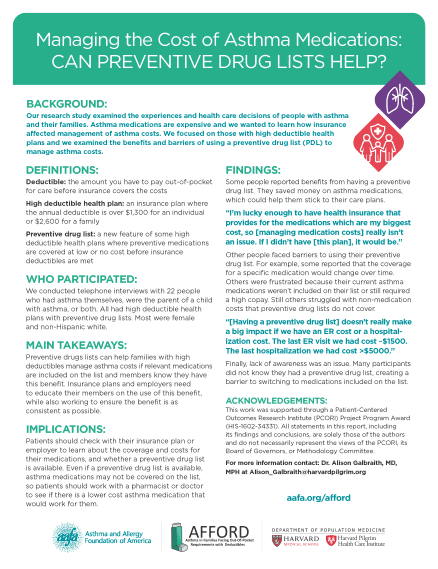Research and Reports
AFFORD (Asthma in Families Facing Out-of-Pocket Requirements with Deductibles) Study
AAFA partnered with the Harvard Medical School and the Harvard Pilgrim Health Care Institute in 2018 to conduct a study to look at experiences and health care decisions of people with asthma and their families. In 2020, we partnered to conduct a study for people with asthma who lost health insurance coverage during the COVID-19 pandemic.

Strategies for Managing Asthma Care Costs
Researchers conducted telephone interviews with individuals who manage asthma either for themselves or a family member to determine strategies for managing asthma care costs. Analysis of the interviews found four overarching strategies:
- Prevention strategies: These strategies focus on ways to decrease asthma symptoms to avoid costs related to asthma treatment. Strategies in this category include minimizing exposure to asthma triggers and closely following recommended treatment plans.
- Shopping strategies: Strategies around shopping aim to reduce costs of needed asthma care. Strategies include comparing medicine prices across pharmacies, using coupons, obtaining free samples, and switching to lower-cost medications.
- Budgeting strategies: These strategies focus on using financial resources to pay for needed asthma treatment. Strategies include putting aside funds such as tax-exempt health savings accounts, or taking on debt to pay for care.
- Skipping recommended care: These strategies focus on reducing asthma management costs by seeking other options. Strategies include skipping medication doses and replacing prescription medicines with alternative treatments.
When it comes to medication adherence, some of these strategies work better than others. Researchers hope that by categorizing these strategies, insurance and other programs can be better designed to reduce costs while keeping families safe.
Benefits and Barriers to Preventive Drug Lists
Another part of the study focused on individuals and families with high deductible health plans. This type of health insurance plan requires individuals to pay higher out-of-pocket costs (deductibles) for care before their insurance covers the cost. At the time of the study, high deductible health plans had a minimum annual out-of-pocket cost of $1,300 for an individual, and $2,600 for families.
Some high deductible health plans provide preventive drug lists (PDLs). These lists include preventive medications that are covered by insurance at low or no cost before insurance deductibles are met. Because asthma is a chronic condition, and preventive medications for asthma can be expensive, researchers also aimed to look at how preventive drug lists can help manage asthma costs.
Among individuals who had high deductible health plans with preventive drug lists, a number of benefits and barriers of using preventive drug lists to manage asthma costs were found:
| Benefits | Barriers |
| Individuals can save money on asthma medications | Coverage for certain medications may change over time |
| Lower costs make it easier to stick to care plans | Current asthma medications may not be on the list or may still require a high copay |
| Non-medication costs (such as emergency room or hospitalization costs) are still expensive, and not covered on preventive drug lists | |
| Non-medication costs (such as emergency room or hospitalization costs) are still expensive, and not covered on preventive drug lists |
The results of this study highlight important benefits of preventive drug lists in high deductible health plans. However, it is important for individuals to know if this resource is available to them. Insurance companies and employers should educate their members on the use of preventive drug lists, while also working to ensure the benefit is as consistent as possible. Patients should also check with their insurance plan or employer to learn about the coverage and costs for their medications, and whether a preventive drug list is available. Even if a preventive drug list is available, asthma medications may not be covered on the list, so patients should work with a pharmacist or doctor to see if there is a lower cost asthma medication that would work for them.
Published articles on this research:
- Strategies commercially-insured families use to manage the cost of asthma care: a qualitative interview study; published January 2022 in the Journal of Asthma
- Preventive drug lists as tools for managing asthma medication costs; published February 2020 in the American Journal of Managed Care

What is the purpose of this research study?
In 2020, AAFA partnered with the Harvard Medical School and the Harvard Pilgrim Health Care Institute to conduct a study for people with asthma who lost health insurance coverage during the COVID-19 pandemic.
We looked for people who:
- lost health insurance during the COVID-19 pandemic
- have asthma and/or have a child with asthma.
What was involved in this study?
This study looked at the effect of an insurance navigation assistance program to help people with asthma regain coverage. The navigation assistance included online information and the opportunity to get insurance information from trained navigators from AAFA.
All participants participated in phone interview at the beginning and end of the study. The intervention group was given access to AAFA’s navigation opportunities. The control group was given access to insurance navigation after 4 months.
Who funded these studies?
These studies is funded by the Patient-Centered Outcomes Research Institute (PCORI). The study is a project of the Asthma and Allergy Foundation of America, the Harvard Pilgrim Health Care Institute and the Department of Population Medicine at Harvard Medical School.

Allergy Capitals
Your location can have an impact on your seasonal allergies. AAFA’s Allergy Capitals™ report looks at the top 100 most challenging cities in the continental United States to live with seasonal pollen allergies.












